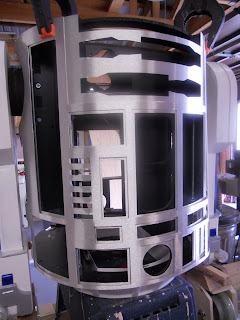
Me holding an FLD while a test sketch is running (Monday, Dec. 19, 2011)
Today is the seventh anniversary of my joining the R2 Builders Group.
I worked on Teeces Version 2 Arduino-based front and rear logic display system this week and was rewarded with blinking lights, just as the design promised.
I pulled the patterns below from the astromech.net site. They look OK, but I'm thinking about replacing some of the FLDs' white lights with blue. The display didn't seem blue enough when it blinked.


The Teeces design makes use of the Arduino microcontroller. I like his approach for several reasons.
I worked on Teeces Version 2 Arduino-based front and rear logic display system this week and was rewarded with blinking lights, just as the design promised.
I pulled the patterns below from the astromech.net site. They look OK, but I'm thinking about replacing some of the FLDs' white lights with blue. The display didn't seem blue enough when it blinked.


The Teeces design makes use of the Arduino microcontroller. I like his approach for several reasons.
- It works. Seriously. It's too easy to follow tangents off the edge of a cliff in droid building. My main goal is to have a passable R2-D2 replica with blinking lights, sound and radio-controlled motion ready for Celebration VI. This FLD/RLD design fits the lights part of the goal.
- It allows for individual LEDs to be selected (it was set up so scrolling text could be put on the logic displays. One of my objectives is to make R2 upgradable. So ... blinkly random lights now, scrolling text and other effects later.
- It uses Arduino. This microcontroller is fascinating to me as an example not only of open-source technology but of small-scale physical computing. It was created by a university group as a cheap way to program interactive projects and has been adopted and adapted by artists, hobbyists and others over the years. Free code written by users is available in the Arduino Playground (such as the LED control library the Teeces design uses), courtesy the open-source approach.
















































